In the heart of Sudan, amidst the vast Nubian Valley, lie the forgotten pyramids of Meroe, a testament to the ancient Kingdom of Kush. These pyramids, while less renowned than their Egyptian counterparts, hold a rich history and architectural significance that rivals any other ancient civilization.
The Kingdom of Kush and Its Pyramids
The Kingdom of Kush, flourishing for nearly a millennium, left behind a remarkable legacy of pyramids, showcasing their unique cultural identity and architectural prowess.
Historical Context
The Kingdom of Kush, spanning from 800 BC to 280 AD, held dominion over a vast territory, influencing the Nile Delta and extending south to Khartoum.
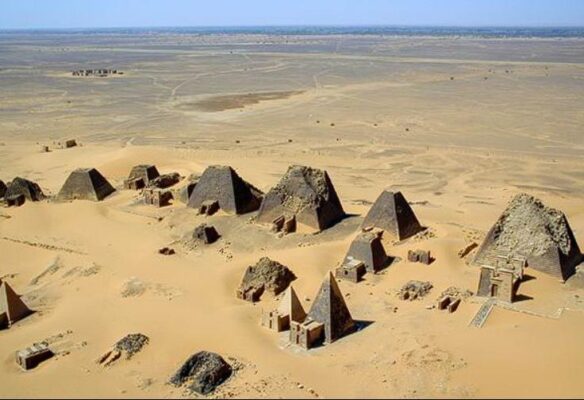
- Flourishing Kingdom:
- The Kingdom of Kush thrived for 900 years, establishing itself as a powerful empire in the ancient world.
- Its influence extended across a significant portion of Northeast Africa.
- Geographical Extent:
- The kingdom’s territory covered a vast area, encompassing much of the Nile Delta and reaching as far south as Khartoum.
- This geographical reach contributed to its political and economic power.
- Meroe as Capital:
- Meroe served as the capital during the kingdom’s final phases, becoming a center of culture and power.
- The city’s strategic location facilitated trade and cultural exchange.
Pyramid Construction
The Nubian pyramids of Meroe, built around 2,500 years ago, reflect the Kushite kings’ fascination with grand structures and their desire to emulate Egyptian traditions.
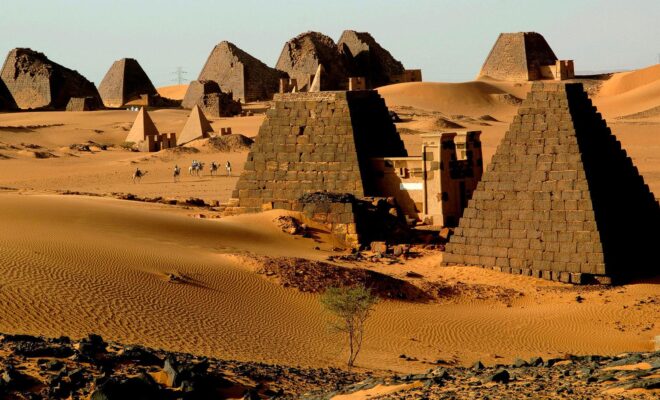
- Post-Egyptian Era:
- The Kushite pyramids were built long after the Egyptians had ceased burying their pharaohs in massive pyramids.
- This timing highlights the Kushites’ unique approach to pyramid construction.
- Emulation of Egyptian Style:
- The kings of Nubia were clearly fascinated by the grand structures of Egypt and sought to imitate them.
- This emulation reflects the cultural exchange and influence between the two civilizations.
- Unique Architectural Features:
- The Nubian pyramids, while inspired by Egyptian models, possess unique architectural features, such as steeper angles and smaller bases.
- These distinctions set them apart from their Egyptian counterparts.
Architectural Characteristics
The pyramids of Meroe exhibit distinct architectural characteristics, showcasing the Kushite builders’ skill and innovation.
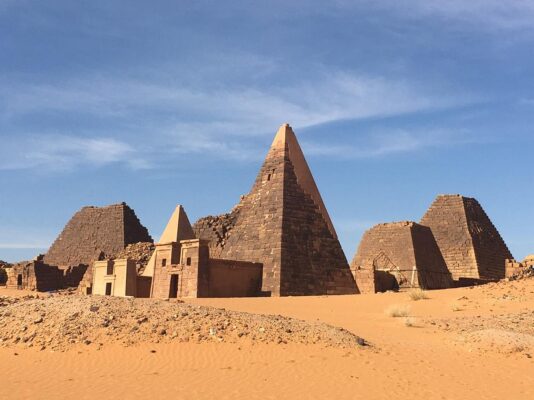
- Reduced Size and Steep Angles:
- The pyramids range in height from 20 to 100 feet, with steep angles and bases rarely exceeding 25 feet.
- These dimensions and angles create a unique visual aesthetic.
- Queen Shanakdakheto’s Pyramid:
- One of the largest pyramids was built for Queen Shanakdakheto, demonstrating the prominence of female rulers in Kushite society.
- Her pyramid is adorned with decorative elements from Egyptian, Greek, and Roman cultures.
- Decorative Elements:
- The sides of the pyramids are decorated with cultural elements from Pharaonic Egypt, Greece, and Rome, reflecting the kingdom’s diverse influences.
- These decorative elements provide insights into the kingdom’s trade and cultural interactions.
Archaeological Discoveries and Cultural Significance
The archaeological discoveries at Meroe provide valuable insights into the Kushite civilization, its burial practices, and its trade connections.
Burial Practices
The Kushite kings were mummified and buried with elaborate rituals and artifacts, reflecting their belief in the afterlife.
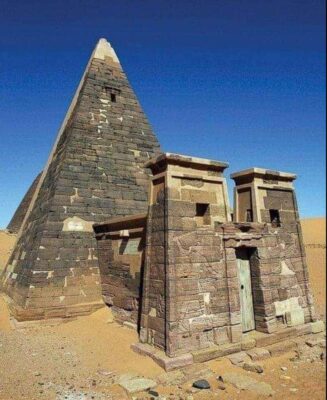
- Mummification and Burial:
- Like the ancient Egyptians, the kings of Nubia were mummified and buried in wooden coffins, covered with jewelry.
- These practices highlight the cultural similarities and shared beliefs between the two civilizations.
- Looted Pyramids:
- Almost all the pyramids were looted centuries ago, resulting in the loss of many valuable artifacts.
- This looting has hindered our understanding of the kingdom’s wealth and cultural practices.
- Archaeological Findings:
- Archaeological explorations in the 19th and 20th centuries revealed remains of arches, arrows, horse harnesses, wooden boxes, furniture, ceramics, stained glass, and metal containers.
- These findings attest to the kingdom’s vast trade networks and cultural sophistication.
Trade and Cultural Exchange
The artifacts discovered at Meroe highlight the kingdom’s extensive trade connections and cultural interactions with Egypt and the Hellenistic world.
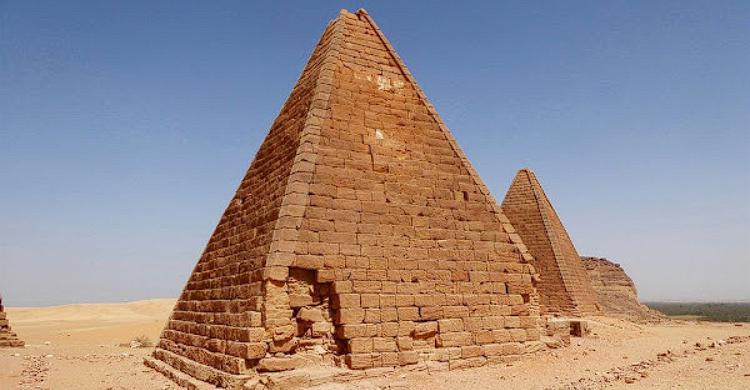
- Trade with Egypt:
- The presence of Egyptian artifacts indicates a robust trade relationship between the Kingdom of Kush and Egypt.
- This trade facilitated the exchange of goods and cultural ideas.
- Hellenistic Influences:
- The presence of Greek and Roman cultural elements reflects the kingdom’s interactions with the Hellenistic world.
- These influences highlight the kingdom’s cosmopolitan nature and its openness to foreign cultures.
- Artifact Diversity:
- The diversity of artifacts discovered at Meroe attests to the kingdom’s vast trade networks and its ability to acquire goods from various regions.
- This diversity underscores the kingdom’s economic and cultural significance.
Legacy and Significance
The Nubian pyramids of Meroe stand as a testament to the Kingdom of Kush’s rich history and cultural achievements, offering valuable insights into ancient African civilizations.
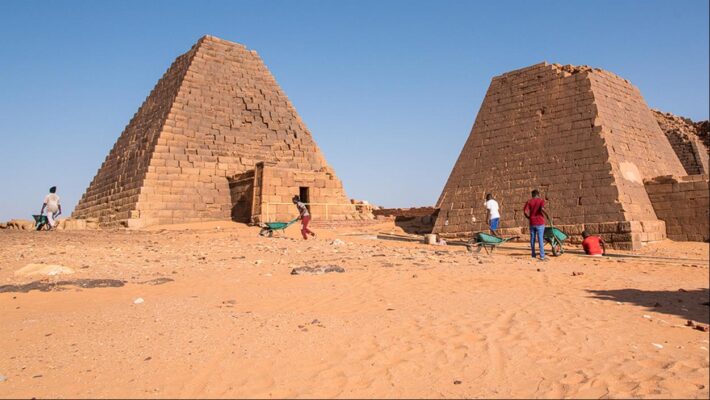
- Architectural Legacy:
- The pyramids represent a significant architectural legacy, showcasing the Kushite builders’ skill and innovation.
- These structures stand as a symbol of the kingdom’s power and cultural identity.
- Cultural Heritage:
- The site’s preservation and study contribute to the preservation of cultural heritage in Sudan and Africa.
- It ensures that the stories and achievements of the Kingdom of Kush are not forgotten.
- Historical Importance:
- The Nubian pyramids of Meroe hold significant historical importance, providing valuable insights into the ancient world.
- They offer a unique perspective on the interactions between African civilizations and the broader ancient world.
The forgotten Nubian pyramids of Meroe stand as a remarkable testament to the Kingdom of Kush, a civilization that left an indelible mark on ancient history. Their unique architectural features, rich cultural heritage, and archaeological significance continue to captivate and educate visitors and researchers alike.

CÁC TIN KHÁC
Mary Walton: The Forgotten Inventor Who Helped Clean Up America’s Cities
Tomb of Queen Nefertari in the Valley of the Queens, Egypt
Discover the Hypostyle Hall of the Temple of Hathor at Dendera
Venus de Losange: Unveiling the Mystery of a 20,000-Year-Old Paleolithic Icon